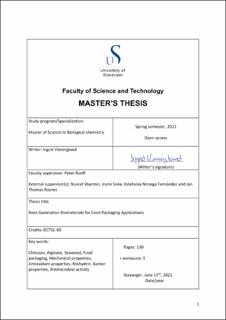| dc.description.abstract | During the recent years, environmentally friendly packaging has become increasingly important for the consumer. However, this shift towards a greener alternative should not come as a compromise on the safety of the product being packaged. The main aim of this study was to investigate two different biopolymers and their usage as packaging material for food packaging applications. Films made from natural biopolymers such as chitosan and alginate were made, and their functional properties were studied. However, in order to achieve films with enhanced functional properties (mechanical, barrier, etc.) suitable for food packaging applications, seaweed was added to the film forming solution followed by HPP treatment.
Chitosan is typically dissolved in acetic acid, which has a quite pungent smell which might lead to rejection by the consumer. Thus, it was investigated if citric acid as a solvent could compare to the properties of chitosan-acetic acid films. The films made with the two different acids showed similar water vapor transmission rates. However, chitosan-acetic acid films were tougher, more flexible and had a higher concentration of free amino groups. Nevertheless, films made with both citric and acetic acid were observed to have relatively good antioxidant properties. HPP treatment was performed on the film-forming solution prior to casting the films. Generally, HPP treatment at pressures of 200 and 600 MPa either decreased the properties in the chitosan films, or the properties remained unchanged. In addition, seaweed was added in different concentrations to investigate if the properties of the chitosan films could improve. However, no such improvement was seen except for increased antioxidant activity at high seaweed concentrations.
Alginate is dissolved in water, so only the effect of HPP treatment and seaweed addition was studied for this polymer. HPP treatment showed some promising effects on the tensile strength of the alginate films at 200 MPa pressure. However, the barrier properties in the films remained unchanged by HPP treatment. Some decrease in antioxidant activity was observed with HPP treatment at 600 MPa pressure. Addition of seaweed showed more promising results. The antioxidant activity of the alginate films increased with added seaweed and some improvement was seen in the WVTR. Nevertheless, the tensile strength of the films was not improved by addition of seaweed, and the elasticity decreased.
Both chitosan and seaweed has been reported to have good antimicrobial properties. These properties were investigated by two types of assays: disc diffusion and liquid-based assays. The disc diffusion assay was not successful due to the films curling in on themselves upon contact with the slight wet media. However, two liquid-based assays were performed at both ideal growth temperate of 37 °C, and 10 °C to simulate more realistic storage temperatures. Chitosan made with citric acid or acetic acid showed higher antimicrobial effect against E. coli than S. aureus at both 24 h incubation at 37 °C and 5 and 10 days incubation at 10 °C. The log concentration in the chitosan samples was below the detection limit for E. coli after 5 and 10 days incubation at 10 °C. Seaweed had no antimicrobial effect at 37 °C, however, some effect was seen for S. aureus at 10 °C. The combination of chitosan and seaweed was also studied at 10 °C. Reduction in CFU/mL were observed for both E. coli and S. aureus after 5 and 10 days incubation at 10 °C, however, the effect was biggest for S. aureus with a complete inhibition after 10 days incubation at 10 °C. | |
